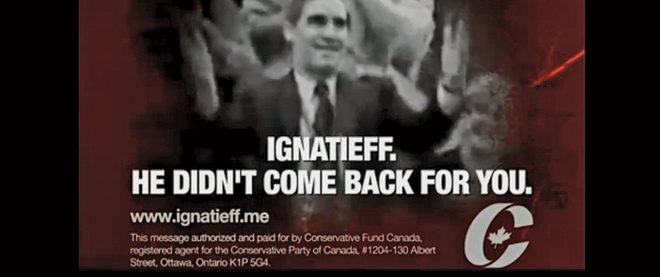We get the politics we pay for
Andrew Coyne on why the Conservatives’ latest attack ads debase us all
Share
 Watching the latest batch of Tory attack ads, the overwhelming feeling is not of revulsion, but fatigue. They’re disgusting enough, in places; the slurs on Michael Ignatieff’s loyalty, the misleading quotations, the half-truths. But my God, are they familiar.
Watching the latest batch of Tory attack ads, the overwhelming feeling is not of revulsion, but fatigue. They’re disgusting enough, in places; the slurs on Michael Ignatieff’s loyalty, the misleading quotations, the half-truths. But my God, are they familiar.
Is there a school somewhere where they churn out these announcers with the perpetual sneer in their voices? Do they get extra credit for mastering the derisory half-chuckle? The grainy surveillance-camera footage, the unflattering images, the sense of mortal danger if this criminal/madman were ever let near the levers of power: how many thousands of times have we seen exactly the same tone, the same approach, the same ads?
That’s not to say there aren’t grains of truth in the ads. It’s true that Ignatieff went along with the last attempt to form a coalition government, and won’t rule out another; that he once proposed a carbon tax; and yes, that he used to live in America. On some of these, criticism is legitimate. But criticism, not vilification. The literal truth of a charge is not sufficient. Tone is also important, as is proportion, and context. That’s if you want to be, you know, persuasive.
Well, of course, they must be persuasive: otherwise they wouldn’t keep running them, would they? Isn’t that what we’re always told, as if by way of justification, that attack ads “work”? Actually, there’s very little evidence that they do. Some may, I don’t doubt. But as a generalization? It’s supposition, mostly, attractive to would-be sophisticates and repeated at every opportunity by the people who make these things for a living.
It wasn’t Tory attack ads that persuaded people Stéphane Dion was “not a leader”—he did that all on his own. Neither did it require an expensive media campaign to convince the public that Ignatieff lacked the common touch, or was ill suited to politics. Indeed, if these ads are so effective, why is it that all the parties remain stuck in the polls, more or less where they have been for years?
Here’s an alternative explanation for why the parties keep going back to the same playbook, time and time again. One, they can’t think of anything else to do. Two, they don’t have to. It’s a bit like the Leafs. No matter how long and unbroken their record of failure, they get to go on repeating the same mistakes. There is never any price to be paid. The money’s always there. Only in this case, it’s the taxpayers’ money.
It was gratifying to see the Prime Minister once again vow, in a recent interview, to repeal the $1.95-per-vote subsidy, on which the parties have come to rely to the tune of millions of dollars every year. But that’s hardly the parties’ only point of access to the taxpayers’ wallets. They benefit as well from the tax credit on political contributions, as much as 75 per cent, not to mention partial reimbursement of their expenses: 50 per cent for parties, 60 per cent for candidates.
Economics teaches us what happens next. Donors are that much less careful with 25-cent dollars than they would be if they were paying entirely out of their own pockets. Parties, likewise, have that much less incentive to maximize the value of every dollar spent. Result: loads of crappy ads, as tiresome as they are inept. As always, wherever subsidies of this kind are available, the effect is to encourage the production of too much of the subsidized goods, with too little regard for quality or cost-effectiveness—and consequent loss of appeal in the marketplace.
Indeed, politics looks very much like an industry in decline. The figures are stark. Not only has the market for politics overall been dwindling—voter turnout in recent elections has hovered around the 60 per cent mark, versus the 75 per cent more typical of our history—but so, more strikingly, is the share of the market controlled by its leading players. A generation ago, the winning party in an election, Conservative or Liberal, could consistently persuade 30 per cent or more of eligible voters to come out to vote for it. In recent elections, that has fallen to 22 or 23 per cent. (That’s the winning party. In the last election, the Liberals’ share of eligible voters fell to just 15 per cent.)
If any other industry were experiencing this sort of catastrophic decline, they would be turning themselves inside out, trying to figure out what they were doing wrong. But because of the easy availability of subsidy—and, as important, because of the very high barriers to entry imposed by the current electoral system, which protect the established parties from newer competitors—the parties are permitted to carry on with the same hackneyed routines. Politics has become a kind of Davie Shipyard, ever more dependent on the very subsidies that are contributing to its decline.
How can we rescue politics from its present moribund state? I think a little tough love is in order: not only unhooking the parties from the per-vote allowance, but every form of subsidy. And, eventually, a breakup of the political cartel within which such mediocrity flourishes.